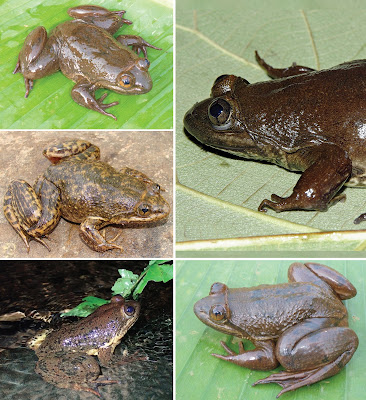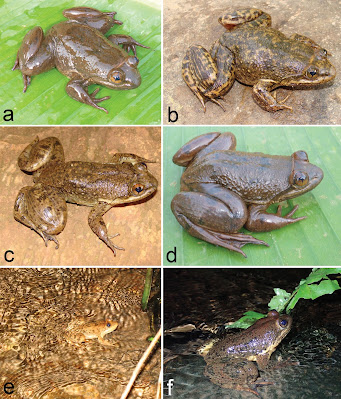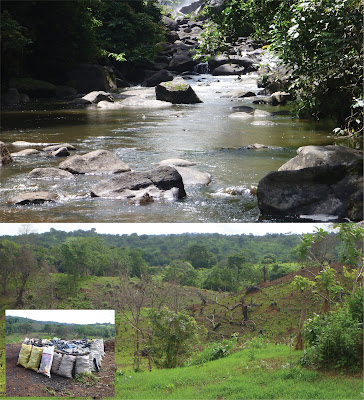 |
| Conraua kamancamarai Neira-Salamea, Doumbia, Hillers, Sandberger-Loua, Kouamé, Brede, Schäfer, Blackburn, Barej & Rödel, 2022 ‘Kaman Camara’s Slippery Frog’ | ‘la grenouille glissante de Kaman Camara’ || ‘Tôti bhowroundi de Kaman Camara’ DOI: 10.3897/zse.98.76692 |
Abstract
We describe a new species of the genus Conraua from the Fouta Djallon Highlands in Guinea. The species is recognised as distinct from nominotypical C. alleni, based on morphological evidence and is supported by a recent species delimitation analysis, based on DNA sequence data. The new species is distinguished from its congeners by the unique combination of the following characters: medium body size, robust limbs, only one instead of two palmar tubercles, the first finger webbed to below the first subarticular tubercle, presence of a lateral line system, indistinct tympanum, two subarticular tubercles on fingers III and IV, venter in adults white with dark brown spots or dark brown with grey or whitish spots. The new species differs from all congeners by more than 6% in the DNA sequence of mitochondrial ribosomal 16S. We discuss isolation in Pliocene and Pleistocene forest refugia as a potential driver of speciation in the C. alleni complex. We also emphasise the importance of conserving the remaining forest fragments in the Fouta Djallon Region for the preservation of both its unique biodiversity and its valuable water sources for local people.
Key Words: Anura, conservation, forest refugia, Upper Guinea forest zone, West Africa
 |
| Conraua kamancamarai sp. nov., female holotype (ZMB 78432) in life. |
Conraua kamancamarai sp. nov.
Diagnosis: The new species resembles other members of the genus Conraua Nieden, 1908. Conraua kamancamarai sp. nov. is an aquatic frog with the following traits: smooth dorsal skin, covered with scattered small, rounded warts on back and longitudinal ridges on dorsal part of hind legs; venter skin smooth; three odontoid projections on lower jaw, one at symphysis and one to each side on dentary; vocal sacs absent; fully webbed feet, i.e. to end of last phalanx of toe. Conraua kamancamarai sp. nov. is closely related to a clade including C. alleni sensu stricto, C. derooi and C. sagyimase (see Blackburn et al. 2020). Genetic distances between the new species and all other Conraua species were higher than 6% in the examined part of the 16S gene.
Etymology: This species is dedicated to Kaman Camara, our long-term field assistant and friend, who started working with MOR in 2002 on a survey to the Simandou Range that was organised by Conservation International (Rödel and Bangoura 2004). From 2007 until his recent death, Kaman was a member of our Guinean team, investigating the amphibians of the Nimba Mountains and other Guinean areas. Kaman had outstanding skills in detecting and catching frogs, and, more importantly, an unswerving positive attitude. A day could be completely exhausting and frustrating, but with a simple joke from Kaman all was good again! Kaman was born and lived in a remote village at the western foothills of the Simandou Range. He never received any formal education. Still, he repeatedly rejected other better paying job offers from mining companies, preferring instead to work with his frog team whenever it was possible. Kaman died in June 2020 after a short severe disease. These frogs shall be a permanent memory to an outstanding person!
We suggest ‘Kaman Camara’s Slippery Frog’ as the English common name, ‘la grenouille glissante de Kaman Camara’ in French and in the local language Poular: ‘Tôti bhowroundi de Kaman Camara’.
Karla Neira-Salamea, Joseph Doumbia, Annika Hillers, Laura Sandberger-Loua, N’Goran G. Kouamé, Christian Brede, Marvin Schäfer, David C. Blackburn, Michael F. Barej and Mark-Oliver Rödel. 2022. A New Slippery Frog (Amphibia, Conrauidae, Conraua Nieden, 1908) from the Fouta Djallon Highlands, west-central Guinea. Zoosystematics and Evolution. 98(1): 23-42. DOI: 10.3897/zse.98.76692
Resumé: Nous décrivons une nouvelle espèce du genre Conraua des hauts plateaux du Fouta Djallon en Guinée. L'espèce est reconnue comme distincte du C. alleni nominotypique, sur la base de preuves morphologiques et est soutenue par une analyse récente de délimitation des espèces, basée sur des données de séquence d'ADN. La nouvelle espèce se distingue de ses congénères par la combinaison unique des caractères suivants: taille moyenne du corps, membres robustes, un seul tubercule palmaire au lieu de deux, premier doigt palmaire jusqu'en dessous du premier tubercule subarticulaire, présence d'un système de lignes latérales, tympan indistinct, deux tubercules subarticulaires sur les doigts III et IV, ventre blanc avec des taches brun foncé ou brun foncé avec des taches gris ou blanchâtre chez les adultes. La nouvelle espèce diffère de ses congénères avec plus de 6% de sa séquence d'ADN du ribosome mitochondrial 16S. Nous discutons de l'isolement dans les refuges forestiers du Pliocène et du Pléistocène comme facteur potentiel de spéciation dans le complexe C. alleni. Nous soulignons également l'importance de conserver les fragments de forêt restants dans la région du Fouta Djallon pour préserver à la fois sa biodiversité unique et ses sources d'eau précieuses pour les populations locales.






